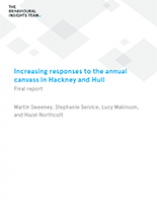The electoral register lists the names and addresses of everyone who is registered to vote in public elections. It is used primarily for electoral purposes but is also used to check credit applications, detect fraud, and call individuals to jury service.
The electoral register is managed at a local level, and it is the duty of Electoral Registration Officers (EROs) to ensure that the register is as accurate and complete as possible.1 However, recent studies have shown that there remain gaps in the register’s completeness, particularly among younger people, non-home-owners, certain ethnic minorities, EU and Commonwealth citizens, and those classified in the lowest social grades.
In order to keep the electoral register accurate and complete, each ERO conducts an annual canvass, in which Household Enquiry Forms (HEFs) are sent to every household in their jurisdiction in order to confirm the details of those living at the property.
54 per cent of households did not respond to the HEF initially during the 2015 canvass.2 In these instances, local authorities are required by law to send reminders and carry out a door to door canvass. If initial response rates to the HEF were increased, local authorities could save time and money. And if response rates by the end of the canvass were increased, both the accuracy and completeness of the register could be increased.
The Behavioural Insights Team partnered with the Electoral Commission to design and test alternative communications with the aim of increasing HEF response rates. This report presents results of a large-scale randomised controlled trial (RCT) that took place during the 2017 annual canvass in Hackney and Hull.

